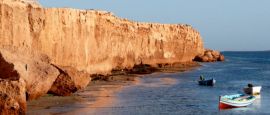Tunisia Weather, climate and geography
Weather & climate
The areas of northern Tunisia that draw the most tourists have a typical Mediterranean climate, with hot, dry summers and mild, occasionally rainy winters. Along with destinations like Egypt and Turkey, Tunisia has claimed a good slice of the Mediterranean summer holiday market, making June to August a popular time for coastal resorts.
Spring and autumn both offer their own enticements though, both in terms of an appealing climate and a lessening of tourist traffic. This is the best time to visit the desert regions of the south and central Tunisia, as in summer the temperatures can climb to stifling heights, whilst in winter the Sahara can be bitterly cold at night.
Winter is low season in Tunisia and hotel prices often drop during the months of December to February. There are still plenty of sun-filled days but temperatures drop substantially once the sun has set and you need to come prepared for rain.
If you’re visiting Tunis, December to March are the rainy season so pack an umbrella with you. May is a lovely time to visit as temperatures averaging 21C (70F). July and August are dry, but hot, averaging 28C (83F).
Sousse, located on the Gulf of Hammamet, has largely the same weather pattern as Tunis, though it is slightly cooler in comparison.
If you are travelling in summer, lightweight clothing made from natural fibres such as cotton and linen are best to cope with the heat. Unless you will be exclusively staying on a resort, pack some longer sleeved tops, and long trousers or skirts for off-the-beach wear. In winter you'll need a rain jacket and a warm pullover to put on for the evenings. It's a good idea to bring these if you're travelling in spring and autumn as well.
Geography
The Republic of Tunisia lies on the North African coast, 130km (80 miles) southwest of Sicily and 160km (100 miles) due south of Sardinia. Dwarfed by its neighbours, sandwiched between Algeria to the west and Libya to the east, Tunisia is just over 163,000 sq km in size. It may be small but Tunisia has a landscape which varies from the cliffs of the north coast, to the woodland of the interior, from desert to rich, arable land, and from mountains to salt pans below sea level.
The 1,148 km (713 miles) Mediterranean coastline is dotted with small islands, notably Djerba in the south and Kerkennah in the east. The coastline is backed by lush pasture, orchards, vineyards and olive groves and is the most populous area of the country.
The north of the country is increasingly mountainous with rolling pine-clad hills a large feature of the landscape. South of Gafsa and Gabès the central region's countryside becomes starker with semi-arid plains as the Sahara begins to exert its influence.
The desert region of the Sahara is one of Tunisia's most famous features. Its diverse environment of mammoth salt pans, vast sand plains and towering dunes, interspersed with lush oases forms the landscape of the south.
Do you have any Feedback about this page?
© 2025 Columbus Travel Media Ltd. All rights reserved. No part of this site may be reproduced without our written permission, click here for information on Columbus Content Solutions.




 You know where
You know where